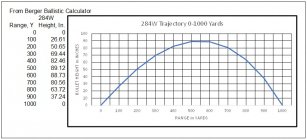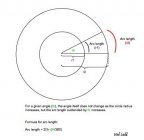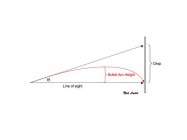Alexander-M
Gold $$ Contributor
(This has been discussed somewhat before, but I have not seen a definitive answer. )
Numerous times I have heard conversations regarding how high our bullets fly on their way to the targets. Some shooters opined that many of the flags that are 10 to 12 feet high were useless since the bullets reach 20 to 30 feet altitude. But looking at our rifles when we shoot, even at 1000 yards, I could not imagine any bullet going 30 feet high since the rifles are essentially level. I believe the error is that they assume that the peak of the trajectory is the same as the bullet drop at the target, and I believe this is incorrect.
Using the Berger Ballistic Calculator, I used 0 as the starting range, and 1000 as the ending range, and plotted the results for 180 gr Hybrid Target bullets at 2825 fps muzzle speed. These show the peak height is at around 500 yards down range, and is closer to 89 inches, or 7-1/2 feet:

What do you think?
Thanks!
Alex
Numerous times I have heard conversations regarding how high our bullets fly on their way to the targets. Some shooters opined that many of the flags that are 10 to 12 feet high were useless since the bullets reach 20 to 30 feet altitude. But looking at our rifles when we shoot, even at 1000 yards, I could not imagine any bullet going 30 feet high since the rifles are essentially level. I believe the error is that they assume that the peak of the trajectory is the same as the bullet drop at the target, and I believe this is incorrect.
Using the Berger Ballistic Calculator, I used 0 as the starting range, and 1000 as the ending range, and plotted the results for 180 gr Hybrid Target bullets at 2825 fps muzzle speed. These show the peak height is at around 500 yards down range, and is closer to 89 inches, or 7-1/2 feet:

What do you think?
Thanks!
Alex












